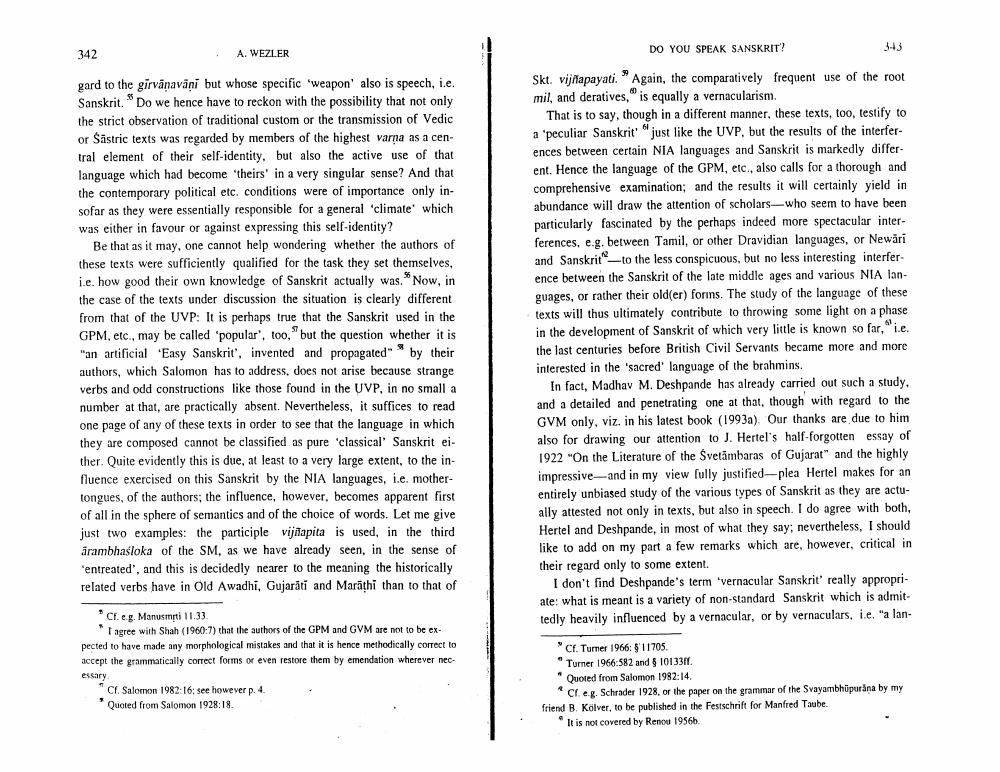________________
342
A. WEZLER
DO YOU SPEAK SANSKRIT?
343
gard to the girvanavani but whose specific 'weapon also is speech, i.e. Sanskrit. Do we hence have to reckon with the possibility that not only the strict observation of traditional custom or the transmission of Vedic or Sastric texts was regarded by members of the highest varna as a central element of their self-identity, but also the active use of that language which had become theirs' in a very singular sense? And that the contemporary political etc. conditions were of importance only in sofar as they were essentially responsible for a general 'climate' which was either in favour or against expressing this self-identity?
Be that as it may, one cannot help wondering whether the authors of these texts were sufficiently qualified for the task they set themselves, i.e. how good their own knowledge of Sanskrit actually was. Now, in the case of the texts under discussion the situation is clearly different from that of the UVP: It is perhaps true that the Sanskrit used in the GPM, etc., may be called 'popular', too, but the question whether it is "an artificial 'Easy Sanskrit', invented and propagated by their authors, which Salomon has to address, does not arise because strange verbs and odd constructions like those found in the UVP, in no small a number at that, are practically absent. Nevertheless, it suffices to read one page of any of these texts in order to see that the language in which they are composed cannot be classified as pure 'classical Sanskrit either. Quite evidently this is due, at least to a very large extent, to the influence exercised on this Sanskrit by the NIA languages, i.e. mothertongues, of the authors; the influence, however, becomes apparent first of all in the sphere of semantics and of the choice of words. Let me give just two examples: the participle vijñapita is used, in the third ärambhasloka of the SM, as we have already seen, in the sense of 'entreated', and this is decidedly nearer to the meaning the historically related verbs have in Old Awadhi, Gujarati and Marathi than to that of
Skt. vijilapayati." Again, the comparatively frequent use of the root mil, and deratives, is equally a vernacularism.
That is to say, though in a different manner, these texts, too, testify to a peculiar Sanskrit just like the UVP, but the results of the interfer ences between certain NIA languages and Sanskrit is markedly different. Hence the language of the GPM, etc., also calls for a thorough and comprehensive examination, and the results it will certainly yield in abundance will draw the attention of scholars-who seem to have been particularly fascinated by the perhaps indeed more spectacular interferences, eg, between Tamil, or other Dravidian languages, or Newari and Sanskrit -to the less conspicuous, but no less interesting interfer ence between the Sanskrit of the late middle ages and various NIA languages, or rather their old(er) forms. The study of the language of these texts will thus ultimately contribute to throwing some light on a phase in the development of Sanskrit of which very little is known so far, i.e. the last centuries before British Civil Servants became more and more interested in the 'sacred language of the brahmins.
In fact, Madhav M. Deshpande has already carried out such a study, and a detailed and penetrating one at that, though with regard to the GVM only, viz. in his latest book (1993a). Our thanks are due to him also for drawing our attention to J. Hertel's half-forgotten essay of 1922 "On the Literature of the Svetāmbaras of Gujarat" and the highly impressive and in my view fully justified-plea Hertel makes for an entirely unbiased study of the various types of Sanskrit as they are actually attested not only in texts, but also in speech. I do agree with both, Hertel and Deshpande, in most of what they say, nevertheless, I should like to add on my part a few remarks which are, however, critical in their regard only to some extent.
I don't find Deshpande's term 'vernacular Sanskrit really appropriate: what is meant is a variety of non-standard Sanskrit which is admittedly heavily influenced by a vernacular, or by vernaculars, i.e. "a lan
Cf. eg. Manusmrti 11.33
I agree with Shah (1960:7) that the authors of the GPM and GVM are not to be expected to have made any morphological mistakes and that it is hence methodically correct to accept the grammatically correct forms or even restore them by emendation wherever nec
essary
C. Salomon 1982:16: see however p.4. Quoted from Salomon 1928:18.
Cf. Turner 1966: $11705. Turner 1966:582 and 510133ff. Quoted from Salomon 1982:14.
Cleg Schrader 1928, or the paper on the grammar of the Svayambhūpurna by my friend B. Kolver, to be published in the Festschrift for Manfred Taube
It is not covered by Renou 1956b.




